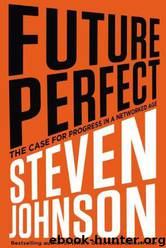Future Perfect: The Case for Progress in a Networked Age by Johnson Steven

Author:Johnson, Steven [Johnson, Steven]
Language: eng
Format: mobi, epub
Tags: Social Science, Science, Motivational, General, Business & Economics, History
ISBN: 9781594488207
Publisher: Penguin
Published: 2012-09-18T00:00:00+00:00
Incentives
We Have a Winner!
The shrub Rubia tinctorum, commonly known as madder, grows delicate yellow flowers in the summer, before small dark red berries begin to line its stems in the early autumn. Belowground, though, lies the plant’s true claim to fame: the meter-long roots that contain a molecular compound called alizarin, which absorbs the blue and green wavelengths of light. From at least the time of the Egyptian pharaohs, the roots of the madder plant have been used to produce striking red dyes. Over the centuries, Indian and Turkish dyers refined an elaborate technique that combined madder roots with calf blood and sheep dung, among many other substances, to produce a brilliant hue that came to be known as “Turkey red.” By the 1700s, the method had been emulated by European artisans, and madder plants were cultivated extensively in the Low Countries.
Among the well-to-do British population of the eighteenth century, fabric dyed with Turkey red was in high demand. Yet the British Isles lacked a meaningful supply of Rubia tinctorum in its fields. Although the Industrial Revolution had triggered a historically unprecedented explosion in the textile industry, a key impediment remained for any cloth that needed to be dyed Turkey red: it had to be shipped across the channel to Flanders. With their new steam engines and emerging industrial labor system, the British had revolutionized the production of cloth in a matter of decades. But they still couldn’t make that cloth a nice shade of red.
On March 22, 1754, a small group of men gathered at Rawthmell’s Coffee-house in Covent Garden and decided to do something about the problem of Turkey red. At this initial meeting, there were eleven of them, a loose network of colleagues and acquaintances, with a strikingly diverse array of professions: naturalists and merchants, watchmakers and surgeons. A drawing teacher and amateur inventor named William Shipley had assembled the group, with the hope of forming a society that would encourage innovation in the arts and in manufacturing. Shipley’s idea was that the group would offer awards—called, in the parlance of the day, “premiums”—for solutions to urgent problems that the group itself would identify. Members would “subscribe” to a fund that would allow the society to announce and promote the premiums, and dole out cash awards when the challenges were successfully met. They called themselves the Society for the Encouragement of Arts, Manufacturers and Commerce in Great Britain, though in the early days they were also known as the “Premium Society,” given the visibility of the awards they offered. Today the institution, one of the most revered in the United Kingdom, is known as the Royal Society of Arts.
At that initial meeting at Rawthmell’s Coffee-house, the eleven men agreed to create two premiums as their inaugural act. Each involved a crucial material for dyeing cloth. One premium offered a reward for the discovery of cobalt ore within the kingdom, thereby facilitating the production of cobalt-blue dyes, and smalt for the creation of blue ceramics. The second premium offered a reward for the cultivation of madder plants on British soil.
Download
Future Perfect: The Case for Progress in a Networked Age by Johnson Steven.epub
This site does not store any files on its server. We only index and link to content provided by other sites. Please contact the content providers to delete copyright contents if any and email us, we'll remove relevant links or contents immediately.
The Secret History by Donna Tartt(16606)
The Social Justice Warrior Handbook by Lisa De Pasquale(11485)
Thirteen Reasons Why by Jay Asher(7779)
This Is How You Lose Her by Junot Diaz(5753)
Weapons of Math Destruction by Cathy O'Neil(5027)
Zero to One by Peter Thiel(4816)
The Myth of the Strong Leader by Archie Brown(4785)
Promise Me, Dad by Joe Biden(4439)
Stone's Rules by Roger Stone(4410)
Beartown by Fredrik Backman(4399)
How Democracies Die by Steven Levitsky & Daniel Ziblatt(4392)
The Fire Next Time by James Baldwin(4336)
100 Deadly Skills by Clint Emerson(4070)
A Higher Loyalty: Truth, Lies, and Leadership by James Comey(4024)
Rise and Kill First by Ronen Bergman(4008)
The David Icke Guide to the Global Conspiracy (and how to end it) by David Icke(3875)
The Farm by Tom Rob Smith(3869)
Secrecy World by Jake Bernstein(3773)
The Doomsday Machine by Daniel Ellsberg(3725)
